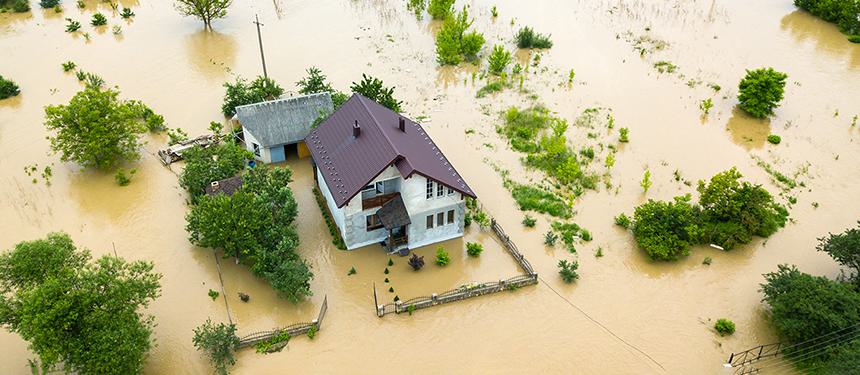Climate risk: fail to prepare, prepare to fail

The impact of climate change is one of the defining issues of today, with individuals, businesses and governments being encouraged to curb their carbon footprint in order to slow global warming.
According to a report by the World Economic Forum, the most severe global risk in 2022 has been climate action failure, followed closely by extreme weather. Throughout 2022, we have seen examples of extreme weather in action – flooding in Pakistan, Australia, Nigeria and Bangladesh were all separately dubbed ‘once in a century’ events. Hurricanes and typhoons have impacted numerous countries in the Americas and Asia Pacific (APAC) respectively, while wildfires and extreme temperatures have accelerated in frequency worldwide.
The Earth’s temperature has risen by 0.08°c every decade since 1880, but the rate of warming has more than doubled since 1981 – it is now rising by 0.18°c every ten years. We recently cited climate risk as being one of five key risks to watch for the year ahead in our Risk Outlook 2023 report, with ‘once in a century’ events now happening yearly and the expectation for business action growing worldwide. It is essential that Risk Managers understand the impact that climate change is having on operations and put in place appropriate mitigation measures from a physical, reputational and regulatory risk perspective.
Understanding and preparing for the impacts of climate risk
Extreme weather incidents are indiscriminate and it is more important than ever that businesses are prepared for the potential impact of an extreme weather event or natural disaster. The physical risks are myriad, ranging from the disruption of supply and distribution chains to the closure of facilities. Disrupted business operations can lead to reduced demand, suppressed profits and increased capital costs. Secondary implications include the ability to get insurance for assets, facilities and operations – several insurers have stated it’s increasingly likely there will be regions of the world they will not be able to insure owing to extreme weather patterns.
The need to adapt and identify viable business continuity plans for the potential physical impact of both extreme weather and natural disasters is paramount. Damage or loss of equipment, infrastructure or even personnel can be mitigated through actionable business resilience risk management. These can include climate-specific forecasting tools to project potential impacts on operations or creating evacuation plans for areas deemed as high risk to limit the potential direct and indirect expenses. Business-specific climate risk mitigation and adaption strategies should be at the heart of any crisis management protocols.

The importance of ESG compliance
Environmental, Social and Governance (ESG) compliance is at the forefront of risks which businesses must consider. Among these risks, climate is at the top of the pecking order, eclipsing governance and social issues at the top of the ESG agenda. The reputational risk of falling foul of ESG practises and expectations is higher than ever – if a company is proven to be failing to adhere to environmentally friendly business practises, criticism can spread via social media in a matter of minutes. Reputation is difficult to establish, but easy to lose.
Companies are now expected to be publicly transparent about practises to move towards net-zero business models and solutions. What was previously regarded as optional is now a requirement. In an Accenture survey in 2021, 64% of CEOs surveyed stated they had advanced net-zero strategies, but only 16% said they were at an advance stage, including measure such as measuring emissions. In the UK, studies show that only 41% of UK businesses are on track to meet net-zero targets set by the government.
Strategies that organisations should implement to ensure ESG requirements are being met are numerous. The need for the mandatory disclose of ESG-specific measures differ from country-to-country, with many companies choose to publish annual voluntary reporting on ESG efforts. In the UK for instance, the Task Force on Climate-related Financial Disclosures (TCFD) provides the framework for disclosure requirements for climate-related factors. While regulatory requirements should be considered, managing the expectations of customers and stakeholders through regular monitoring of perception and service delivery should also be amalgamated into ESG measuring and reporting.
Cop27 – a stark reminder
Since Cop27 kicked off in Egypt on 6th November, numerous global leaders have reiterated pledges to meet emissions targets, while calling on organisations to be transparent when disclosing their emissions. It remains to be seen whether the numerous external shocks of 2022, such as Russia’s invasion of Ukraine and the associated economic and operational disturbance, will cause disruption to these global emission targets. The discrepancy between commitments and targets are already a driver for many environmental protest movements, as organisations are being encouraged to do more to adopt environmental practises and cut down on carbon emissions.
Cop27 is a yearly reminder of the global push towards becoming carbon neutral, and the role individuals, organisations and governments have to play. For businesses, it is important pitfalls are avoided; allegations of greenwashing – misleading stakeholders about environmental impacts – can cause significant reputational risks. By clearly stating ESG visions and goals, either through a statement, yearly reporting or more granular measurables, companies can ensure ESG best-practises are being met in a transparent manner. Although there is no ‘one size fits all’ solution for ESG practises, Healix can help businesses assess which areas of the organisation could be exposed to ESG risks and how best to mitigate these risks. Learn more.


